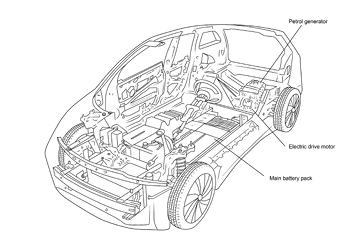There are five main variants of vehicle that are loosely grouped under the umbrella of the term EV or Electric Vehicle. In its purest form, there is the BEV or Battery Electric Vehicle that is powered solely on recharged batteries. These vehicles are rapidly becoming the first and greenest choice of electric vehicle. The following EV types are listed chronologically in their green ranking, with most efficient first.
AVAS. In the EU, from July 1st 2019, all 4 wheel
Fact
electric cars must be fitted with an AVAS
[Acoustic Vehicle Alert System] at low speed.
following concerns that pedestrians were at
risk because the cars could not be heard as they
approach.
BEV – Battery Electric Vehicle
A BEV is powered by either 1 or 2 indirect electric motors, or by 4 integrated hub motors, each controlled by an electronic motor controller that manages functions such as limited slip differential, torque, regenerative braking and incremental speed shifts.
A BEV obtains its electric power by plugging in to a public or home charger that is normally connected directly to the electrical grid or via a BESS (Battery Energy Storage System) often used to collect energy from Solar, wind or other alternative energy sources. This variant of EV uses no direct fossil fuel to power it, nor is there any tailpipe emissions. Typical examples include the latest Nissan® Leaf, BMW® i3 BEV, Chevrolet® Volt, Tesla® S and Jaguar® iPace.
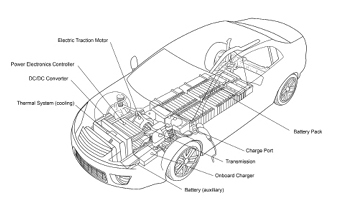
FCEV – Fuel Cell Electric Vehicle (Hydrogen)
The FCEV type of EV is powered by a hydrogen fuel cell. This normally delivers a steady current to the cars in-built battery pack, through a battery management system and then the car can be driven in the same way that a pure battery powered car is operated. The FCEV has similar green characteristics to the BEV as it also emits no tailpipe pollution, just clean water – the by-product of the chemical reaction caused by the fuel cell converting hydrogen and oxygen from the air into electricity.
On some FCEVs the electricity is then stored in onboard batteries similar to the BEV and the stored power is used to regulate the power driving the motors of the EV.
The hydrogen is stored in secure tanks within the car and it needs to be refilled at one of just a handful of nationwide refilling stations. The principle of Fuel cell powered EVs is similar to REHEV cars, since the fuel cell often acts a generator of electricity to charge the small stack of batteries. On other FCEV designs, the fuel cell drives the motors via a motor control system direct.
Nevertheless, there can be a modicum of noise pollution with some fuel cell powered vehicles, due to the noise of a compressor used in the design, depending on the variant of vehicle. Generally, FCEVs are more complex than simple BEVs and demand much more maintenance. Furthermore, charging station infrastructure is scarce at the moment. But the main benefit is that there is no tailpipe pollution with either variant of FCEV. Typical examples of FCEV include Hyundai® NEXO, Toyota® Mirai and Honda® Clarity.
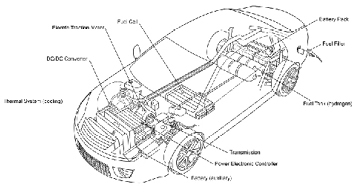
FCEV is effectively a Hybrid Electric Vehicle
using a fuel cell module powered by methane
or hydrogen, often supplying a battery for
propulsion
Fact
PHEV – Plug in Hybrid Electric Vehicle
PHEVs employ a small lower voltage battery pack compared to BEVs and are used to power an auxiliary electric motor that is linked to the conventional transmission system or in some cases, powers the rear wheels, whilst the main ICE (Internal Combustion Engine) powers the front wheels. The in-built battery storage is much smaller than a BEV and provides much lower ‘all electric’ range compared to a BEV.
A PHEV obtains its electric power by plugging into a public or home charger that is normally connected directly to the electrical grid or via a BESS (Battery Energy Storage System) often used to collect energy from Solar, wind or other alternative energy sources.
The PHEVs main energy source is from Petrol Gasoline or Diesel, to power its internal combustion engine. This EV variant does produce significant tailpipe emissions and can normally only be driven on battery power for short distances ranging from 6 to 30 miles, depending on the model. Typical examples include Mitsubishi® PHEV, Range Rover® Sport PHEV, Audi® A3 PHEV and Cadillac® CT6 PHEV.
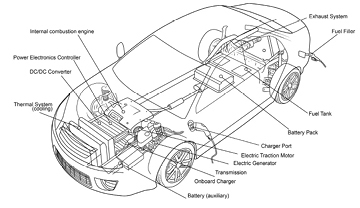
HEV – Hybrid Electric Vehicle
The HEV variants combine battery storage with an internal combustion engine. This EV type has an electric auxiliary motor, normally assisting the main engine via a link to its main transmission system. It often comes with regenerative braking.
HEVs rely on petrol gasoline or diesel for their main source of power and have no external facility or function to enable its battery pack to be charged by an external charger. The batteries are most commonly charged by the engine and also during the braking process. This EV variant produces significant tailpipe emissions and can normally only be driven on battery power for short distances ranging from 5 to 20 miles, depending on the model. Common examples of this car type are all Toyota® hybrids, Lexus® hybrids and Hyundai® hybrids.
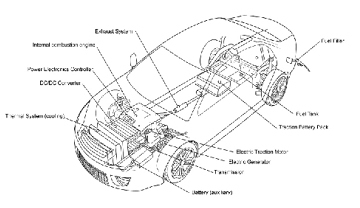
REHEV – Range Extender Hybrid Electric Vehicle
REHEV variants are similar to a pure BEV with the added range security of a petrol gasoline powered generator. The generator is not connected directly to the drive train, instead it charges the battery pack direct.
This EV variant is losing popularity now and when used in range extender mode, produces tailpipe emissions. Examples are BMW® i3 REX, Vauxhall® Ampera REX and Chevrolet® Volt REX.
